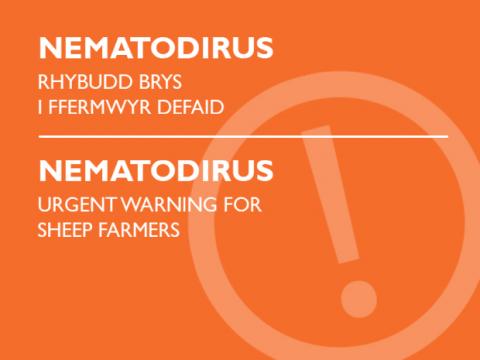SCOPS has teamed up with researchers at the University of Bristol* again to provide a Nematodirus risk forecast for 2017.
It is available on the SCOPS website and predicts when Nematodirus eggs will hatch in an area and therefore when there is a risk of a disease outbreak. The model features daily updates using weather station data, meaning more localised, real time advice on treatments and management actions throughout the spring and early summer. ‘Predicting when outbreaks might happen is becoming increasingly difficult due to variation in spring temperatures from year to year’ says Hannah Rose who heads up the project at the University of Bristol. ‘Farmers can no longer rely on a standard timetable of treatments to avoid disease. Nor can we rely on faecal egg counts (FECs) because the damage is done by the immature larvae, so farmers need a reliable warning system. We have been improving this forecast since it started in 2013 and in a survey of users on the SCOPS website last year, 60% of respondents said they had significantly changed their approach to Nematodirus control as a result of the service and over 90% had made some changes.’ Hannah adds.
* UK Government funding provided by the Biotechnology and Biological Sciences Research Council (BBSRC)
How Does it Work?
The forecast takes advantage of the temperature-dependent synchronised hatching of the Nematodirus larvae. Using real time weather data from 140 weather stations provided by the Met Office and Dark Sky it can predict the date of hatching and how long the larvae will remain infective on the pasture. This is then overlaid on to an interactive Google map, allowing farmers and their advisers to select the nearest or most representative weather station. A click on your nearest station reveals advice on how to relate the predicted risk to your flock and management and treatment options will be available.
‘SQPs can play a vital role in this’, says Hannah. ‘By being aware of the overall risk levels in your area and also promoting the use of the forecast map to individual customers, SQPs can help farmers to understand the implications for their flock based on their location and management history’.
The height above sea level is provided for each weather station so the risk level can be adjusted for individual farms using the rule of thumb that hatch will occur roughly 1 week later for every 100m above sea level. Previous grazing management and history of Nematodirus infections can be also used to assess risk and Hannah thinks this is where the SQP can add real value by maintaining long-term relationships with clients. ‘Although faecal egg counts (FECs) are not useful to determine the need to treat for Nematodirus, they are vital in showing us where contamination is highest, identifying paddocks that are likely to be high risk next season’ say Hannah.
Give us Feedback please!
The Bristol team are also asking farmers, SQPs, Vets, advisers and diagnostic labs to submit reports of cases of nematodirosis or reports of eggs in faecal egg counts for mapping anonymously alongside the forecast. This will help users to interpret the risk forecasts and will help with future development by providing further data to test predictions. Please submit reports with the first half of the postcode of the affected holding and details (e.g. group faecal egg count lambs 10 weeks of age, 500 epg Nematodirus) to hannah.rose@bristol.ac.uk.
Facts about Nematodirus
- Nematodirosis is caused by the gutworm Nematodirus battus. It can be deadly and affects young lambs, typically 6-12 weeks of age
- Eggs deposited on pasture by lambs the previous year and then hatch together in spring, triggered by a period of chilling over winter followed by a period of time spent between 11.5°C and 17°C
- Risks are highest when we have a cold spell followed by an increase in temperatures
- Young lambs take in large numbers of larvae as they graze, which damage their gut leading to foetid black diarrhoea (black scour) and death
- Farmers should avoid putting young lambs on paddocks that may have been contaminated with Nematodirus eggs the previous grazing season, particularly if the paddocks were previously grazed by ewes with young lambs
- Young lambs should be treated to prevent Nematodirus throughout the period when there is a high risk forecast. More than one treatment may be necessary at 3 week intervals dependent on the spread of ages in the group and if the high risk forecast is prolonged
- Anthelmintics in the 1-BZ (white) class are still the treatments of choice for Nematodirus battus. Despite the widespread resistance of other worm species to the white wormers, Nematodirus battus remains susceptible on the majority of farms and can be used even on farms with known resistance issues in other worms. However, we must be vigilant and report suspected cases of BZ-resistant Nematodirus battus: the first such cases have been recently reported in the UK
- You can follow up treatments with a drench check (faecal egg count reduction test) to check for Nematodirus eggs which if present indicate treatment failure
For more information go to www.scops.org.uk

